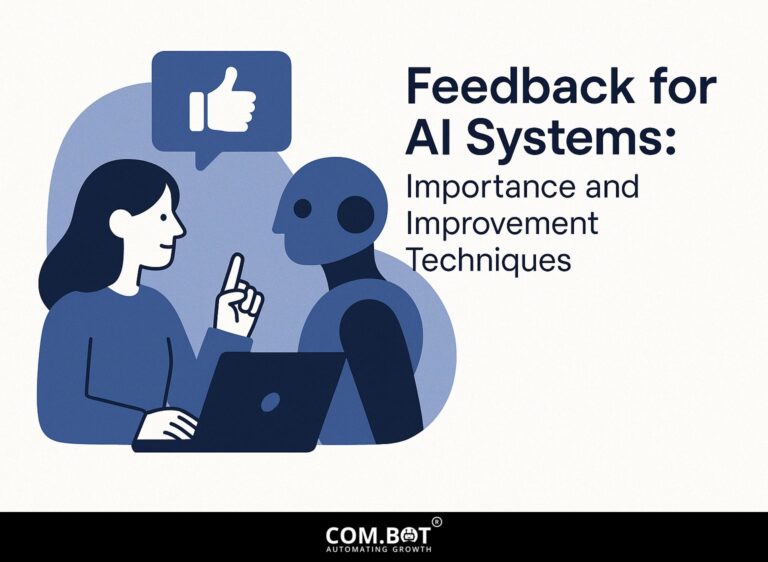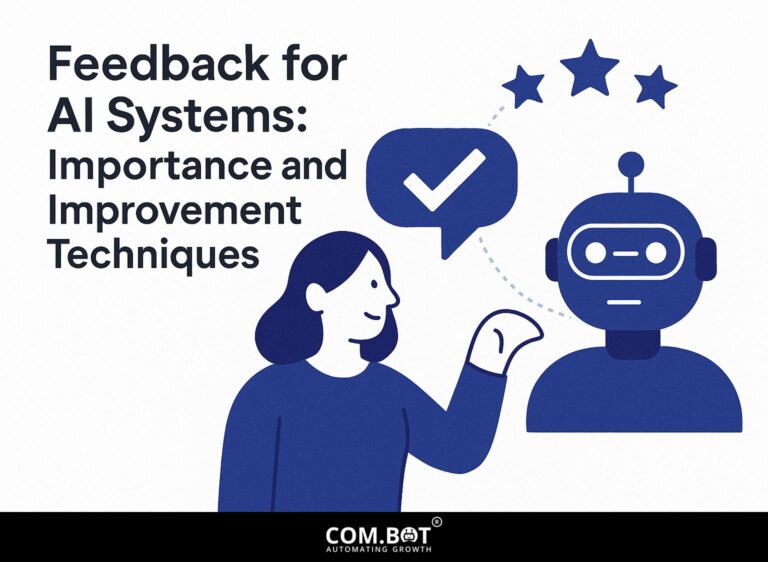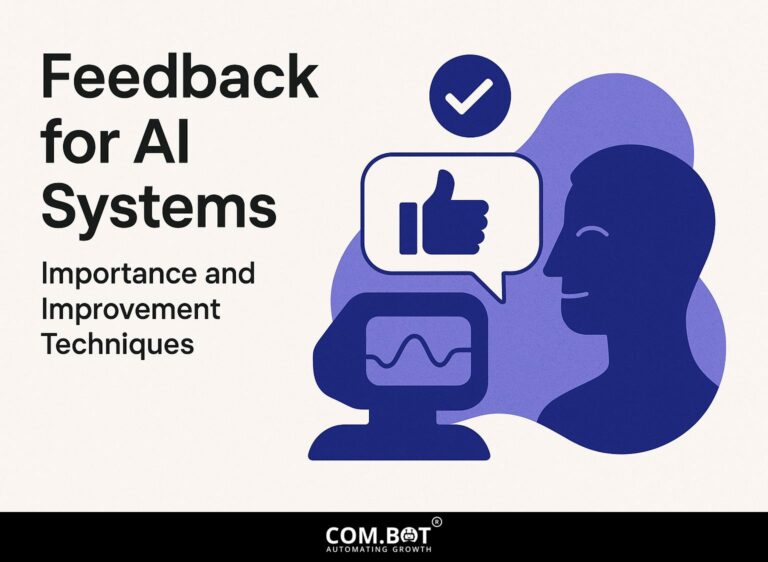Feedback for AI Systems: Importance and Improvement Techniques
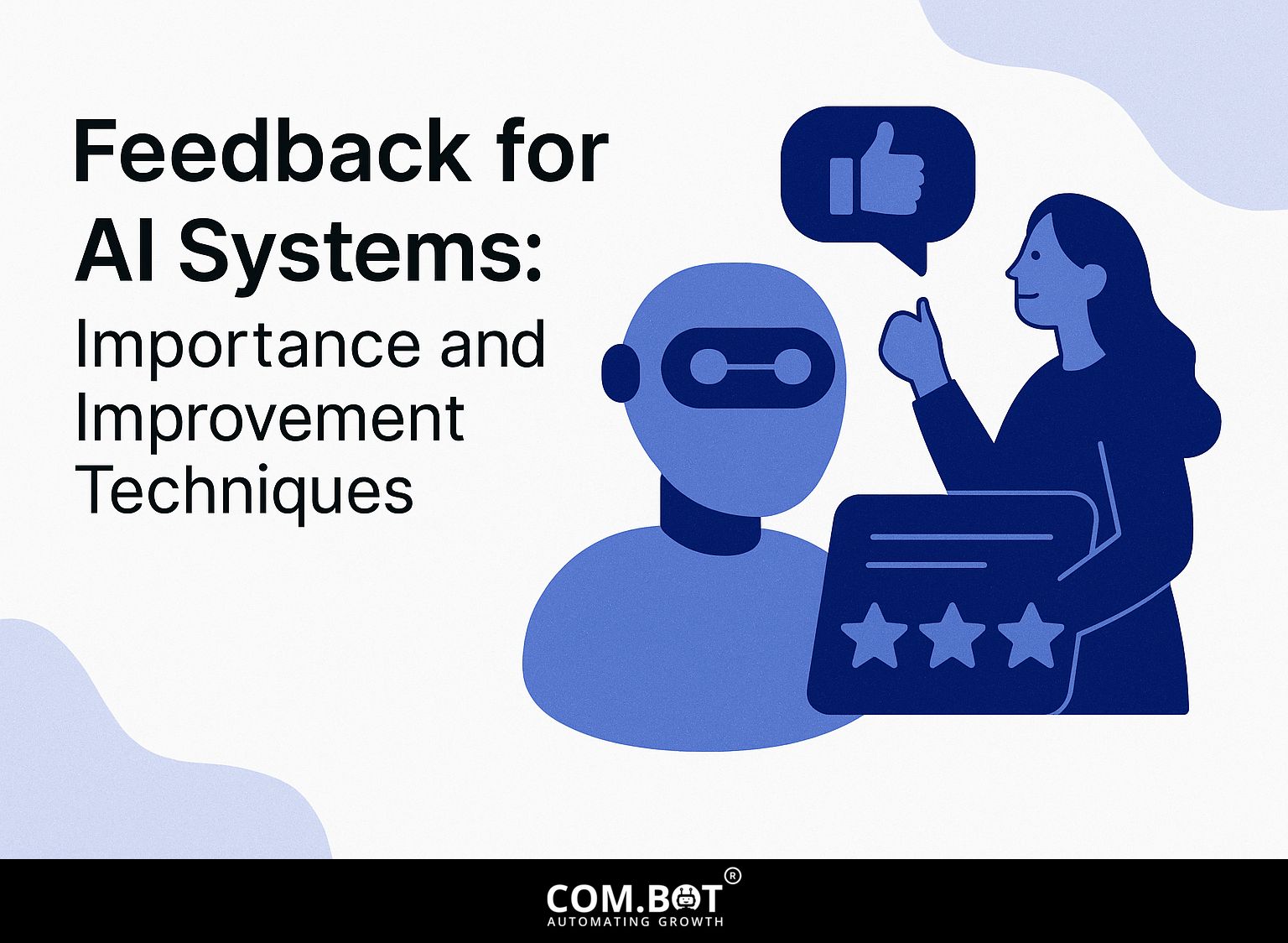
In the fast-changing field of artificial intelligence, giving useful feedback to AI systems is essential for improving how they work and making sure they are dependable. As machine learning algorithms become more prevalent, monitoring and refining these systems through structured feedback mechanisms is essential. This article looks at why feedback is important in AI development, explains different ways to use it, and shows how it can improve user experience while addressing typical problems. Learn how to improve AI systems with helpful ideas!
Key Takeaways:
- 1 Types of Feedback Mechanisms
- 2 Benefits of Effective Feedback
- 3 Challenges in Implementing Feedback
- 4 Techniques for Gathering Feedback
- 5 AI Feedback Metrics and Evaluation
- 6 Case Studies of Successful Feedback Implementation
- 7 Future Trends in AI Feedback Systems
- 8 Frequently Asked Questions
- 8.1 What is the importance of feedback for AI systems?
- 8.2 How does feedback help in improving AI systems?
- 8.3 What are some common techniques for providing feedback to AI systems?
- 8.4 Why is it important to use diverse sources of feedback for AI systems?
- 8.5 How can we make sure that feedback provided to AI systems is correct and fair?
- 8.6 Can AI systems learn from their own mistakes and improve without external feedback?
Definition of Feedback in AI Systems
Feedback in AI systems is the information provided to machine learning models to improve their behavior and increase their accuracy over time.
There are two primary types of feedback used in AI: supervised learning and reinforcement learning.
In supervised learning, the model learns from labeled datasets, where each input is paired with the correct output. A practical example is using image recognition, where a model is trained on thousands of labeled images.
Reinforcement learning uses a method where the agent learns by trying different actions and receiving rewards or penalties. For example, a robot learns to move through a maze by getting rewards when it reaches the end.
Both approaches are essential for refining AI performance.
Importance of Feedback for AI Development
Using good feedback methods can make AI systems better, increasing their performance by up to 30% in different uses.
One clear way to encourage this feedback is by using data from how users interact. For example, companies like Google use how people search to constantly improve their algorithms.
Utilizing tools such as A/B testing allows teams to compare different model outputs effectively. Incorporating regular review cycles where developers analyze model predictions against real-world data can reveal trends and necessary adjustments.
This repeated process increases model accuracy and updates systems to meet changing user needs, keeping them relevant and useful.
Types of Feedback Mechanisms
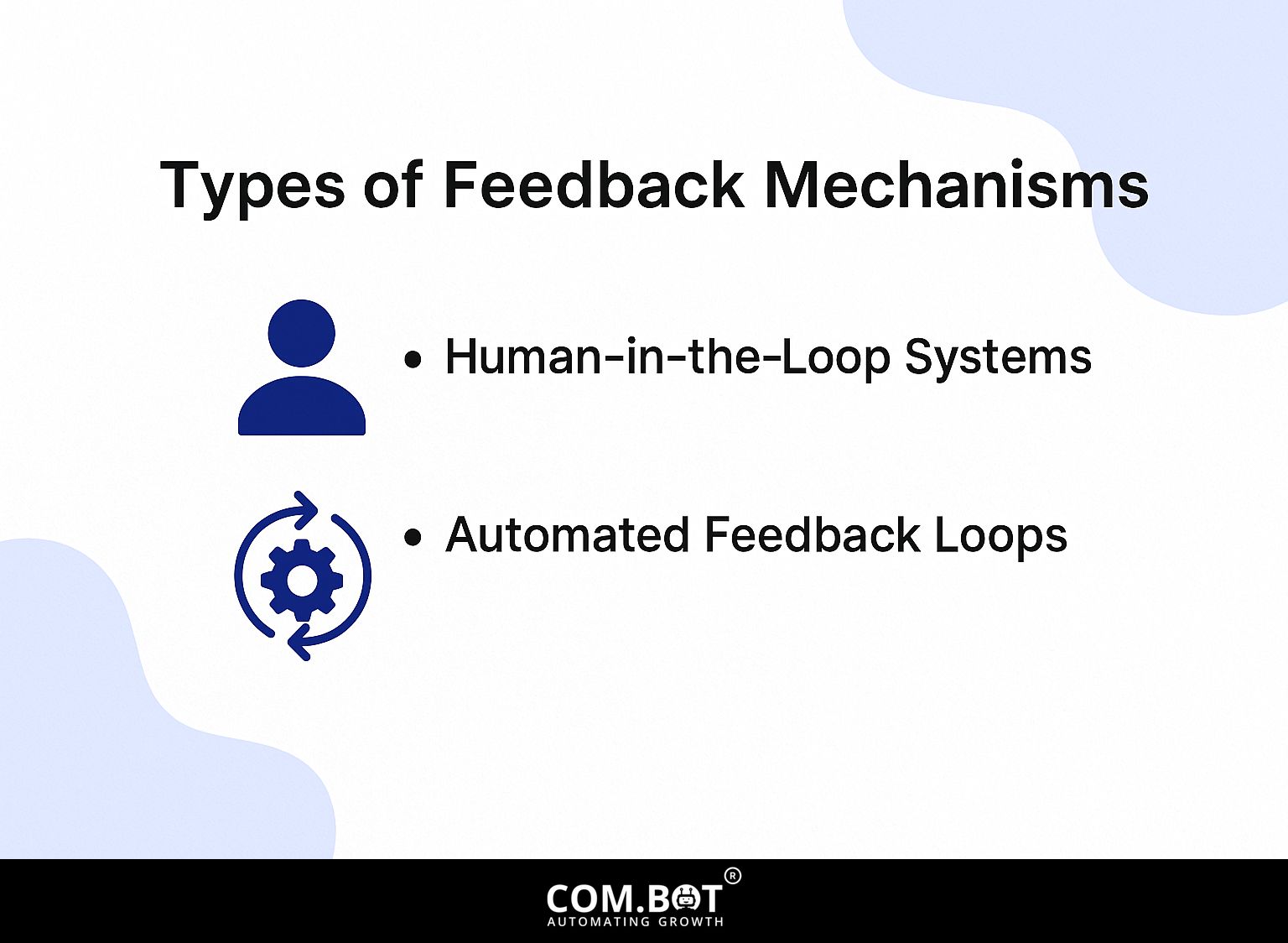
Feedback methods can generally be divided into systems that involve human input and those that work automatically, each having different roles in improving AI. To explore these roles further, consider our detailed guide on feedback for AI systems, which outlines the importance and techniques for enhancement.
Human-in-the-Loop Systems
Human-in-the-loop systems integrate human judgment into AI processes, significantly improving accuracy, especially in complex tasks like image recognition.
For example, Amazon Mechanical Turk can be used to collect human feedback for labeling data in training datasets. Having people tag images helps companies improve model results, making sure uncommon or detailed categories are accurately recognized.
Platforms such as Labelbox help teams organize datasets and make changes based on human input. This repeated process improves the quality of AI models and speeds up learning, resulting in more dependable results in practical uses.
Automated Feedback Loops
Automated feedback systems use current data to continually make AI models work better, which is important for tasks like forecasting results and identifying irregular patterns.
These loops can be implemented using tools such as TensorFlow and Azure Machine Learning. For instance, TensorFlow’s Keras API allows you to create models that automatically adjust based on training data results.
Unlike others, Azure Machine Learning provides automatic machine learning (AutoML), choosing models and changing settings instantly using active feedback.
By using these tools, businesses can make better decisions, work more effectively, and quickly react to market changes, promoting a culture focused on using data for new ideas.
Benefits of Effective Feedback
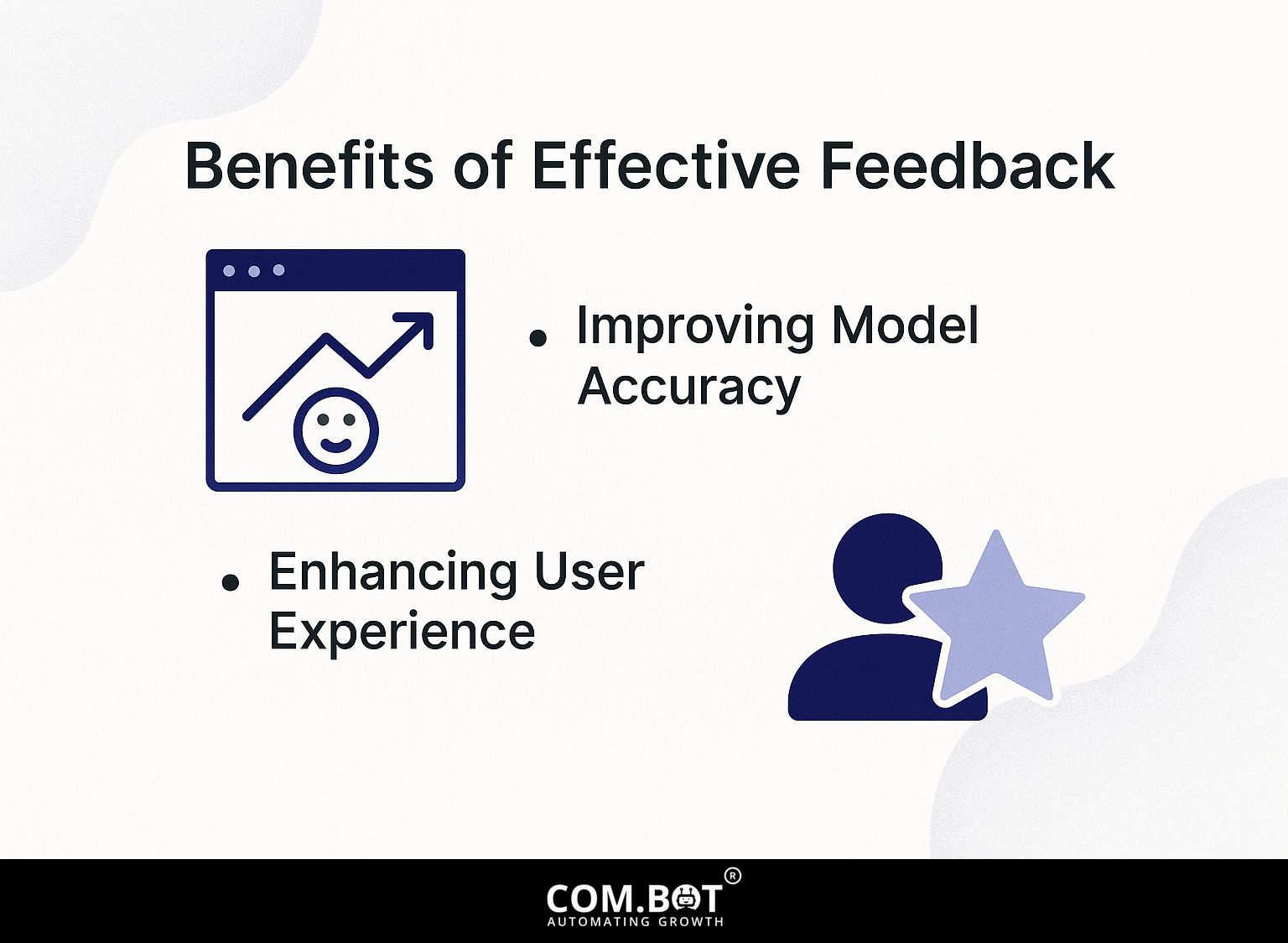
Providing useful feedback can improve AI model accuracy by up to 50% and make user interactions much better through customized experiences. This enhancement aligns with strategies for managing high volume and ensuring scalability (our detailed exploration of AI bot scalability and efficiency delves deeper).
Improving Model Accuracy
Using strong feedback systems can improve model accuracy by 40%, as shown in different machine learning uses.
Organizations like Google and Microsoft have integrated structured feedback systems into their machine learning workflows.
Google updates its Search algorithms using feedback from users, which helps the company change how it ranks results based on user activities. Similarly, Microsoft employs user feedback loops in its AI products, allowing continuous improvement based on real-world applications.
By frequently collecting and reviewing feedback-such as user ratings and performance data-these companies can quickly improve their models, resulting in more accurate and effective outcomes.
Enhancing User Experience
Feedback systems make user interactions more personal, which leads to a 20% rise in user engagement numbers.
Netflix and Spotify use user feedback to quickly make content suggestions that fit individual preferences. Netflix analyzes viewing habits and collects user ratings to improve its recommendation system.
Custom suggestions increase the chances of users watching recommended shows by 75%. Spotify’s ‘Discover Weekly’ playlists analyze users’ preferences and select songs they are likely to enjoy, increasing user satisfaction.
Adopting similar feedback-driven strategies can help other platforms create targeted content, enhancing overall engagement and retention.
Challenges in Implementing Feedback
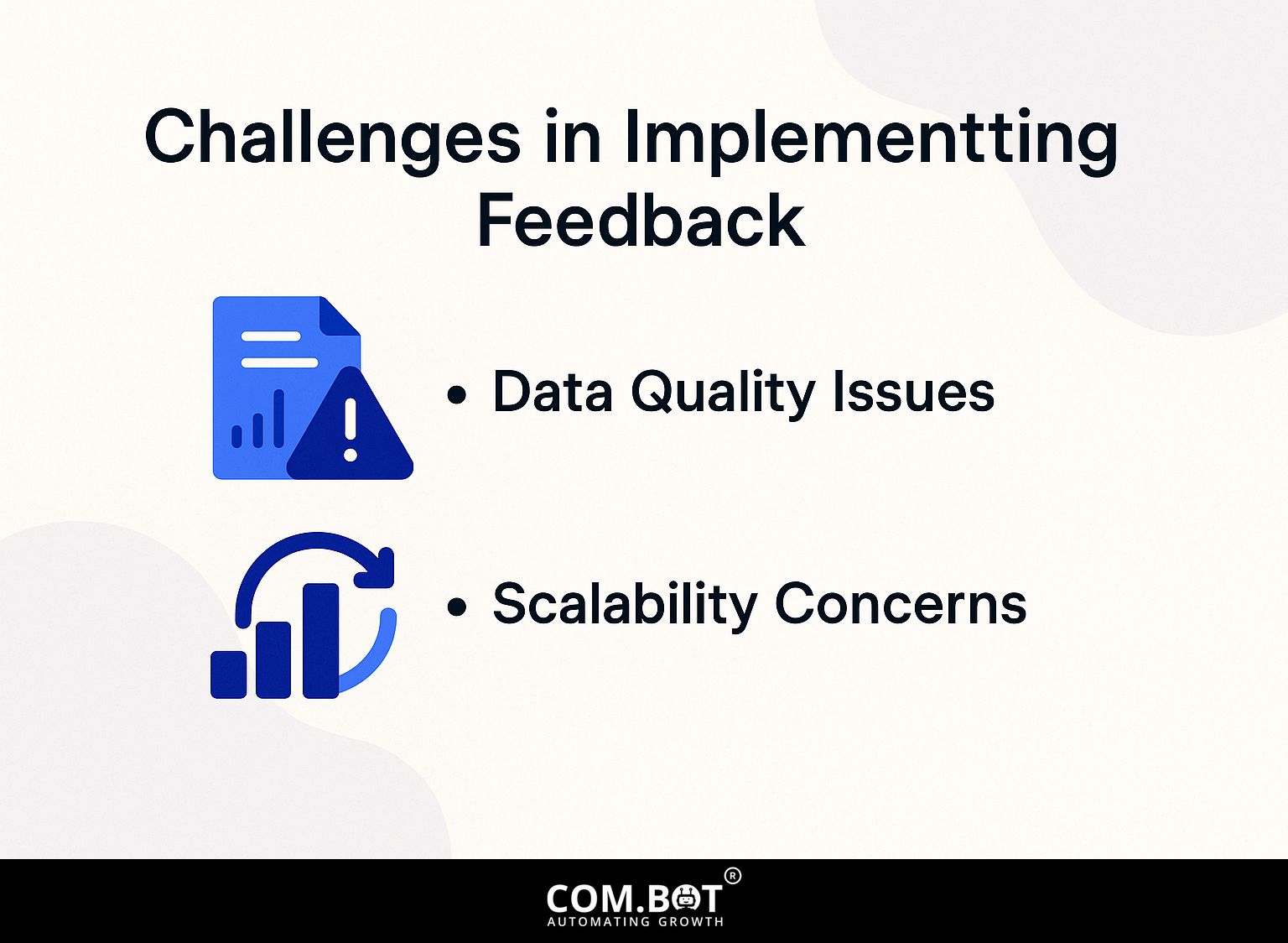
While helpful, feedback systems can be hard to put into practice due to problems with data accuracy and growth that may affect efficiency. For more on improving feedback mechanisms, see our guide on Feedback for AI Systems: Importance and Improvement Techniques.
Data Quality Issues
Data quality issues can significantly impair feedback effectiveness, with poor data quality leading to model inaccuracies and misinterpretations.
To make sure data is correct and reliable, begin by checking its accuracy using various techniques. For example, use tools like Talend or Apache Nifi to automatically clean and format incoming data.
Next, establish clear protocols for data entry, ensuring that all team members follow a standardized process. Regular checks are important; schedule these every three months to spot any errors.
Educate your team on the best practices for managing information, focusing on the need for correct data entry and maintenance. This approach builds reliable feedback systems and enhances decision-making.
Scalability Concerns
When there is a lot of data, feedback systems can struggle to handle it quickly and correctly, which affects how fast and accurate the models are.
To solve these problems, using cloud services like AWS and Azure can be very important.
For instance, AWS offers auto-scaling groups that adjust capacity based on demand, ensuring your feedback system remains responsive during peak loads.
Azure, on the other hand, provides machine learning services with built-in scalability, allowing models to handle extensive datasets without slowing down.
By using these platforms, you can improve processing speeds and keep accuracy, effectively handling scalability problems in real-time analytics.
Techniques for Gathering Feedback
You can collect useful feedback using different methods like user surveys, interviews, and reviewing performance metrics.
AI Feedback Metrics and Evaluation
AI Feedback Metrics and Evaluation
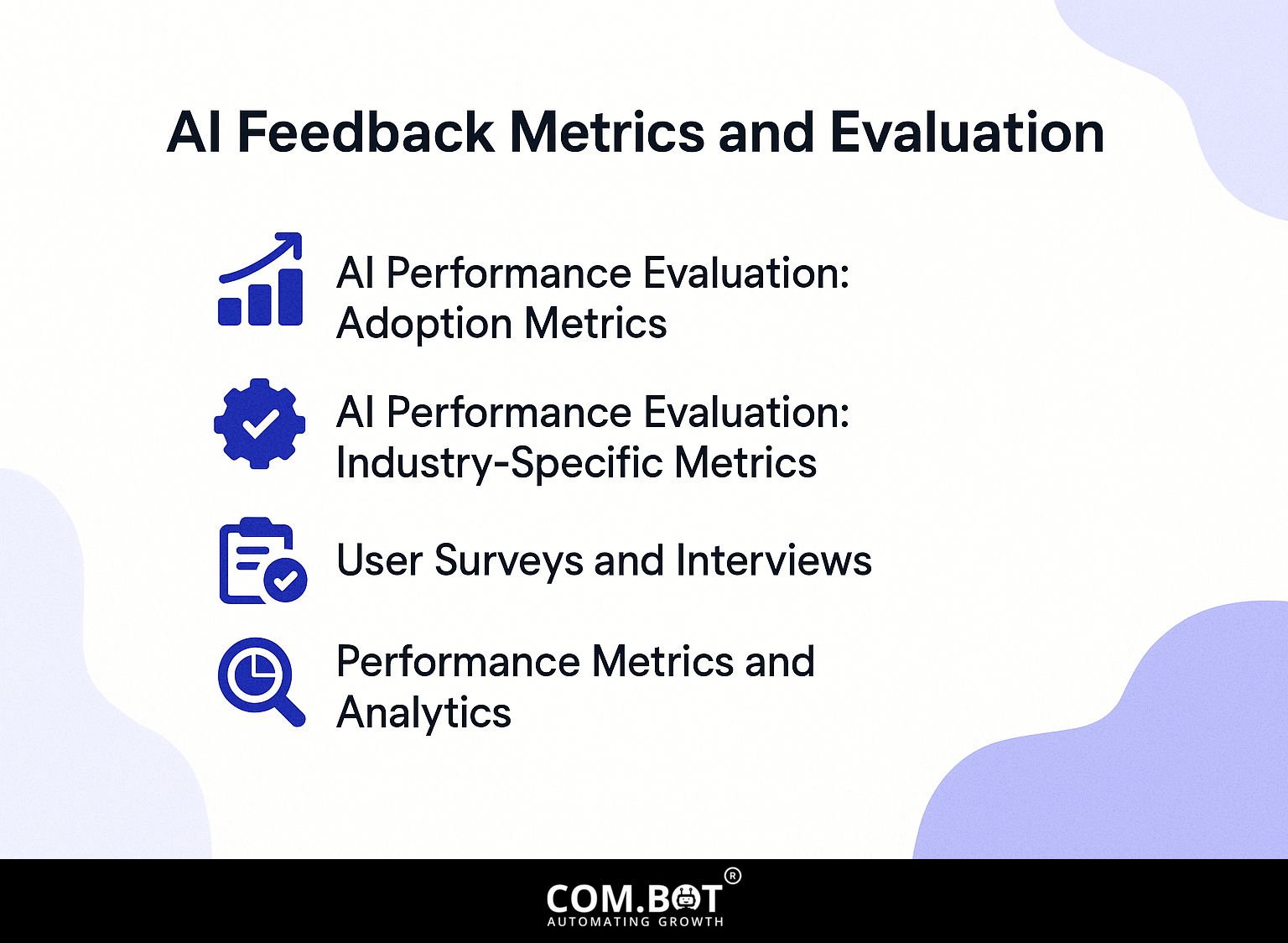
AI Performance Evaluation: Adoption Metrics
AI Performance Evaluation: Industry-Specific Metrics
The AI Feedback Metrics and Evaluation data provides a full view of how Instagram is used in influencer marketing and brand promotion. It shows its increasing use by online stores and fashion brands. This dataset offers information on how Instagram can be used effectively for marketing due to its large audience and focus on visuals.
AI Performance Evaluation presents two important dimensions: Adoption Metrics and Industry-Specific Metrics. In the context of Adoption Metrics, 46.7% of influencer marketing takes place on Instagram, emphasizing its significance in digital marketing strategies. The platform is great for brands wanting to increase their visibility and interaction by working with influencers. Additionally, with 53.0% Influencer marketing using Instagram Reels in the U.S. is showing a move towards engaging content types that hold user interest better.
- Industry-Specific Metrics reveal a nearly universal adoption among fashion brands, with 98.0% utilizing Instagram to reach their target audiences. This high percentage illustrates how integral Instagram has become in fashion marketing, offering brands a space to showcase their products through engaging content.
- Further analysis shows that 86.0% of U.S.-based online stores use Instagram, compared to 81.0% in the UK and 75.0% in Germany. These numbers indicate a strong reliance on Instagram across different regions, although with slight variations that could reflect market saturation levels, cultural differences in social media use, or varying degrees of e-commerce maturity.
Overall, the AI Feedback Metrics and Evaluation Data shows Instagram’s important part in today’s marketing plans, proving it’s useful for influencer marketing and as a place to increase online store visibility. Brands, particularly in fashion, are capitalizing on its features to create impactful marketing campaigns, while geographic variations highlight opportunities for growth in certain markets.
User Surveys and Interviews
User surveys and interviews can provide useful information that greatly improves AI systems, with response rates averaging 30% if organized well.
To create effective surveys, use tools like SurveyMonkey or Google Forms. Begin by asking open-ended questions such as ‘Which feature do you like the most?’ Include rating scales for specific elements, ensuring that the meaning of each point on the scale is clear.
For interviews, set up a semi-structured format that allows you to discuss both new ideas and key topics. Contact various groups to collect different ideas, and review helpful comments for greater clarity.
This method raises response rates and improves the quality of the data collected.
Performance Metrics and Analytics
Utilizing performance metrics and analytics tools like Google Analytics and Tableau allows organizations to track feedback effectiveness quantitatively.
By regularly checking how users interact, organizations can find out which content connects best with their audience. For example, monitoring metrics such as bounce rates and session durations helps to evaluate how users are interacting with specific pages.
Tools like Hotjar can provide heatmaps to visualize user behavior, guiding content adjustments. Setting up goal tracking in Google Analytics can measure conversions, showing the direct impact of user feedback on business objectives.
This method, based on data, increases how well the content fits the audience and raises customer satisfaction.
Case Studies of Successful Feedback Implementation
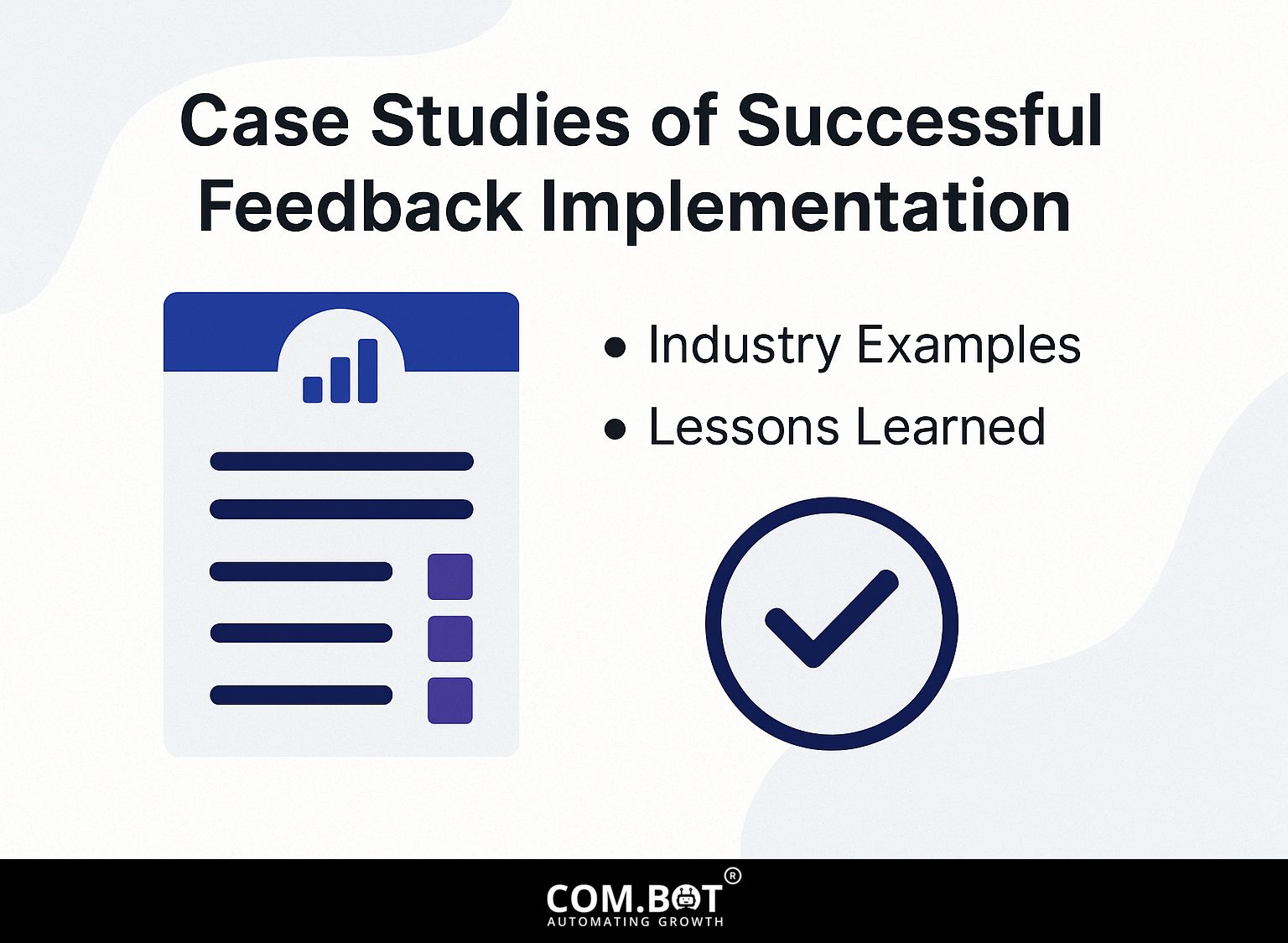
Examples of how feedback has been used successfully show useful information about how well different feedback methods work in different fields. One of our hidden gems delves into the feedback techniques specifically tailored for AI systems, highlighting their importance and ways to enhance their effectiveness.
Industry Examples
Companies like IBM and Netflix have successfully used feedback systems to improve how they work and increase user satisfaction.
Both companies use modern feedback systems to make better progress.
For example, IBM uses the NPS (Net Promoter Score) system to measure how loyal their customers are and find parts of their service that need improvement. In contrast, Netflix uses real-time viewer feedback on its platform to change content recommendations and buy new shows based on user preferences.
By studying this data, IBM made its service faster, cutting response times by 30%, while Netflix kept viewers watching longer by 20% by carefully choosing content.
These specific strategies show the significance of feedback in encouraging new ideas.
Lessons Learned
Feedback system implementations show the importance of regularly changing and checking the system to keep it working well.
To improve your feedback system, set up regular meetings and assessments. For instance, schedule quarterly reviews to assess the relevance of your feedback channels and adjust them based on user engagement.
Use tools such as SurveyMonkey to gather user feedback and Google Analytics to monitor engagement trends.
Set up a system where contributors get updates on how their input influenced decisions. This builds trust and teamwork.
Changing these things makes your feedback system work better and gets more people to join in seriously.
Future Trends in AI Feedback Systems
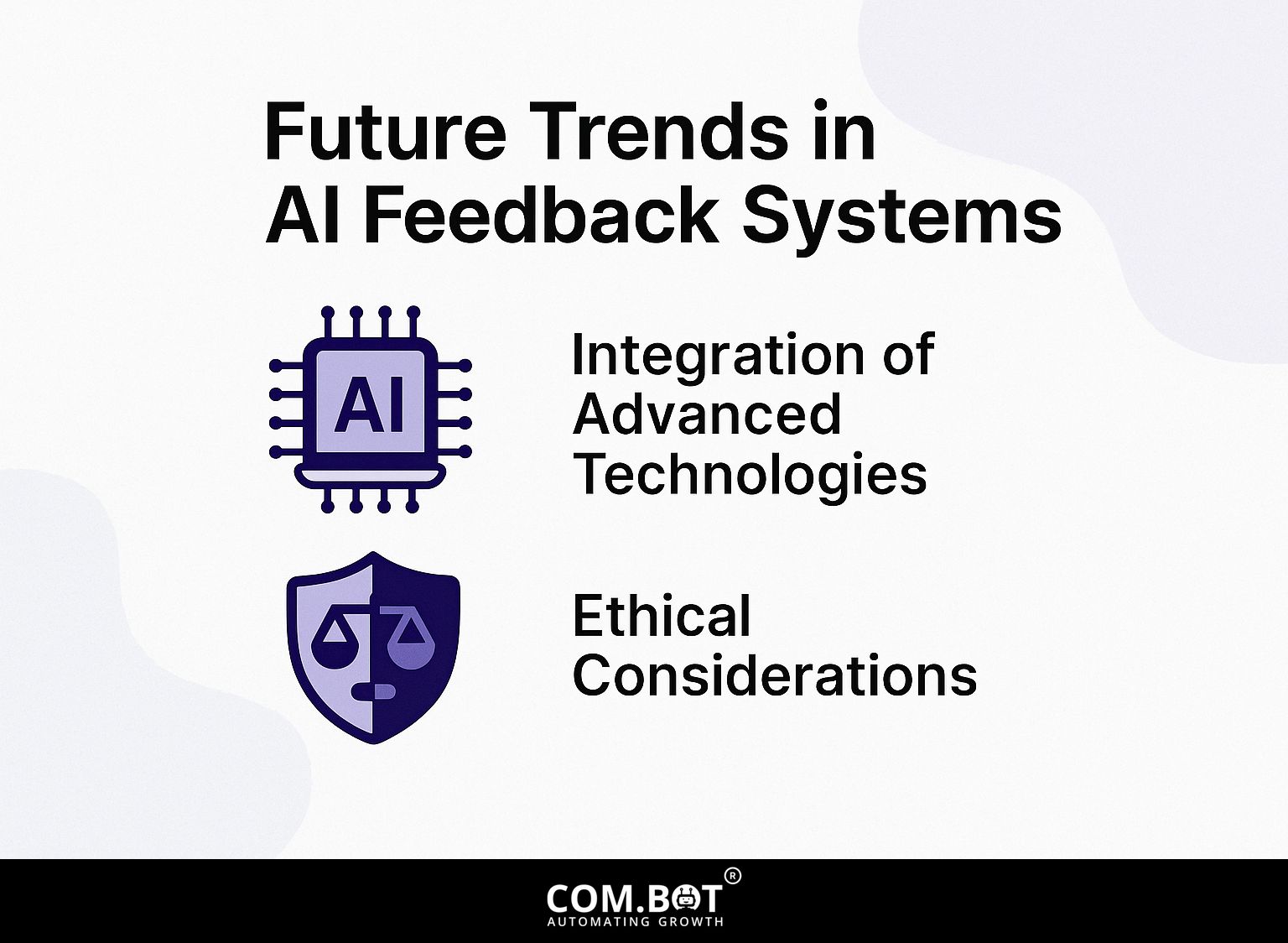
AI feedback systems are set to change with the use of new technologies such as machine learning and data visualization. For further insight into the importance of feedback in these systems and how to improve them, see our detailed discussion on feedback improvement techniques for AI systems.
Integration of Advanced Technologies
Using advanced technologies like reinforcement learning and predictive analytics in feedback systems can make them more flexible and effective.
Using reinforcement learning helps AI systems make better choices over time by learning from user interactions.
Programs like TensorFlow provide structures to create these models. Meanwhile, predictive analytics, using software such as Tableau or Power BI, can analyze historical data to inform system adjustments.
By frequently reviewing user comments and how well the system works, organizations can improve algorithms to better match what users need.
Creating a continuous feedback loop will make AI systems more responsive and effective, leading to better results.
Ethical Considerations
Ethical issues in AI feedback systems are becoming more important. Organizations need to handle concerns about bias, privacy, and getting user permission.
Organizations should regularly check their AI systems to find and reduce biases, ensuring ethical practices.
Utilizing tools like Fairness Flow or IBM Watson can help analyze algorithms for fairness and transparency.
Setting up clear consent rules, asking users for feedback on data use, and using privacy methods like differential privacy are important.
Teaching employees about ethical AI practices helps create a responsible work environment.
By adopting these strategies, organizations can promote trust and accountability in their feedback systems.
Frequently Asked Questions
What is the importance of feedback for AI systems?
Feedback helps AI systems to keep getting better and learn from errors. Without feedback, AI systems would not adjust to different conditions and would struggle to make correct predictions or choices.
How does feedback help in improving AI systems?
Feedback helps in improving AI systems by providing them with information on their performance. This helps them identify and correct errors or bias in their algorithms, leading to more accurate and effective results.
What are some common techniques for providing feedback to AI systems?
There are different methods to give feedback to AI systems. These include feedback from people, using artificial data, and reinforcement learning. Each technique has its own benefits and is used depending on the specific needs of the AI system.
Why is it important to use diverse sources of feedback for AI systems?
Using feedback from different sources makes sure that AI systems see various viewpoints and data. This helps reduce biases and makes their predictions more accurate. This is especially important in fields like healthcare and finance, where unfair decisions can cause serious results.
How can we make sure that feedback provided to AI systems is correct and fair?
To get accurate and fair feedback, choose the sources of feedback with care and keep an eye on the data being used. Putting checks and balances in place can find and fix possible biases in the feedback process.
Can AI systems learn from their own mistakes and improve without external feedback?
AI systems can learn from their own mistakes and improve without external feedback, but this process will be significantly slower and less efficient. Feedback from outside sources offers a wider range of information for AI systems, helping them learn more quickly and accurately.
